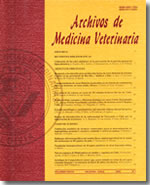Radiographic, arthroscopic and biomechanical findings in dogs with ruptured anterior cruciate ligament
Main Article Content
Abstract
The aims of this study were to describe the clinical signs associated with gait disturbances, and correlate the results of radiographic and arthroscopic examination and gait analysis in force platform, in dogs with naturally occurring rupture of the anterior cruciate ligament (ACL). 10 dogs with clinical rupture LCA were used in this study. On admission each dog was evaluated to find out the degree of arthroscopic and radiologic joint damage and the type of gait disturbance by force plate gait analysis. Radiographic examination was not correlated with arthroscopic findings. Radiological changes were less severe than the direct joint evaluation during arthroscopy. There was variation in gait disturbances. The distribution of body mass support was 66.38% for forelimbs and 33.62% for the affected limbs. We found a strong negative correlation (ρ = –0.80) between the degree of synovitis and gait speed. The results derived from this research let us to conclude that 1) arthroscopy is necessary to establish the actual joint compromise. 2) Radiographic signs are not correlated with arthroscopic findings and, 3) synovitis was the main cause of abnormal gait in the dogs of this study.

